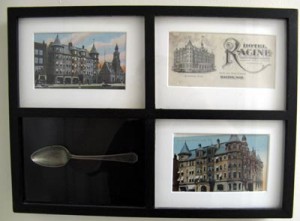A few years after I got interested in the history of Racine, Wisconsin, I stumbled across the idea of concentrating on a single location or building and then finding as much information as possible on that subject. For me, this allowed me to not get overwhelmed by the mass of information available out there, and I found that once I got something pretty thoroughly documented, other interesting connections then became obvious, and I had another subject to concentrate on.
Often when I would visit Racine, I would find myself walking through a neighborhood and I would wonder, “What if I had a book for this spot that would tell me everything that happened here, everything that people were talking about as they passed this spot, every car accident, every parade, every proclamation?” And that thought would send me off onto another line of research. For instance, when I walked past 333 Main Street and saw “Leonard Studio” set into the sidewalk in front of the building, I took a picture, and eventually found out many interesting details about the photography business that had stretched across two generations, and even had a remote connection to one of my favorite subjects, Racine College.
Occasionally, we are lucky enough to have some very detailed documentation about a single place. For instance, in the book, Rooted in Hope: The Story of the Dominican Sisters of Racine, Wisconsin, we have a wonderful record of years and years of conversations, classes, church services, thoughts, and feelings of the sisters who ran the Dominican convent on the block bounded by College Avenue and Park Avenue, 12th Street and 13th Street.
After a while, I started to think of this particular way of approaching history as “microhistory,” because the researcher has to concentrate the way a microbiologist would concentrate while looking through a microscope. As usual, someone else has already coined this term, and microhistory is considered to be a subdiscipline of the study of history. Wikipedia has a fairly brief entry on microhistory, but it shows that other people are pursuing this method of research.
Throughout this Racine History website, you will find various microhistories, usually about a single place or building. Here are some examples in no particular order:
1405 College Avenue
Racine College
Hotel Racine
Paris Royal Cleaners
